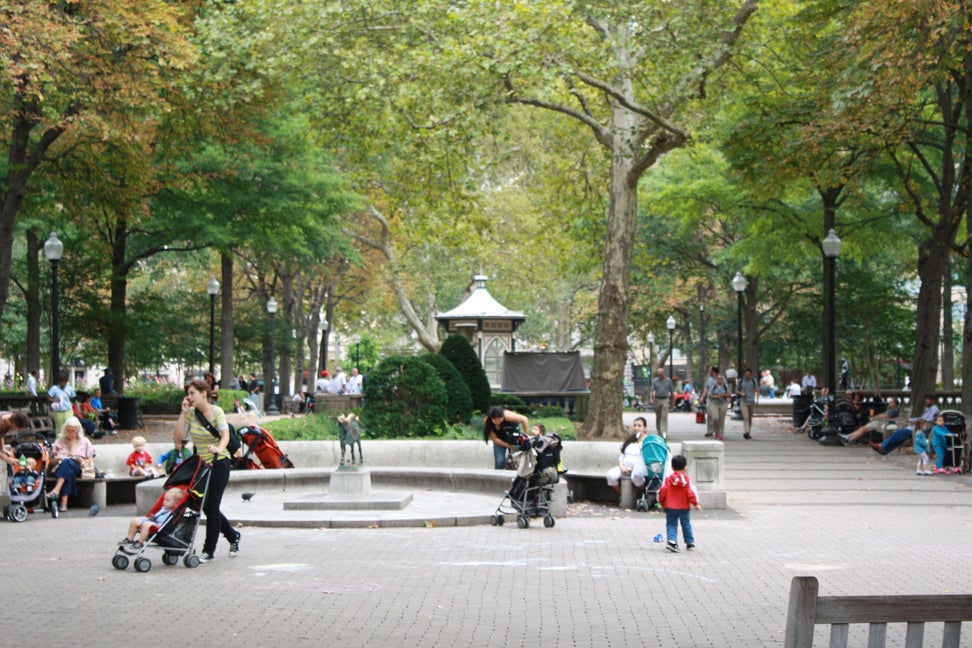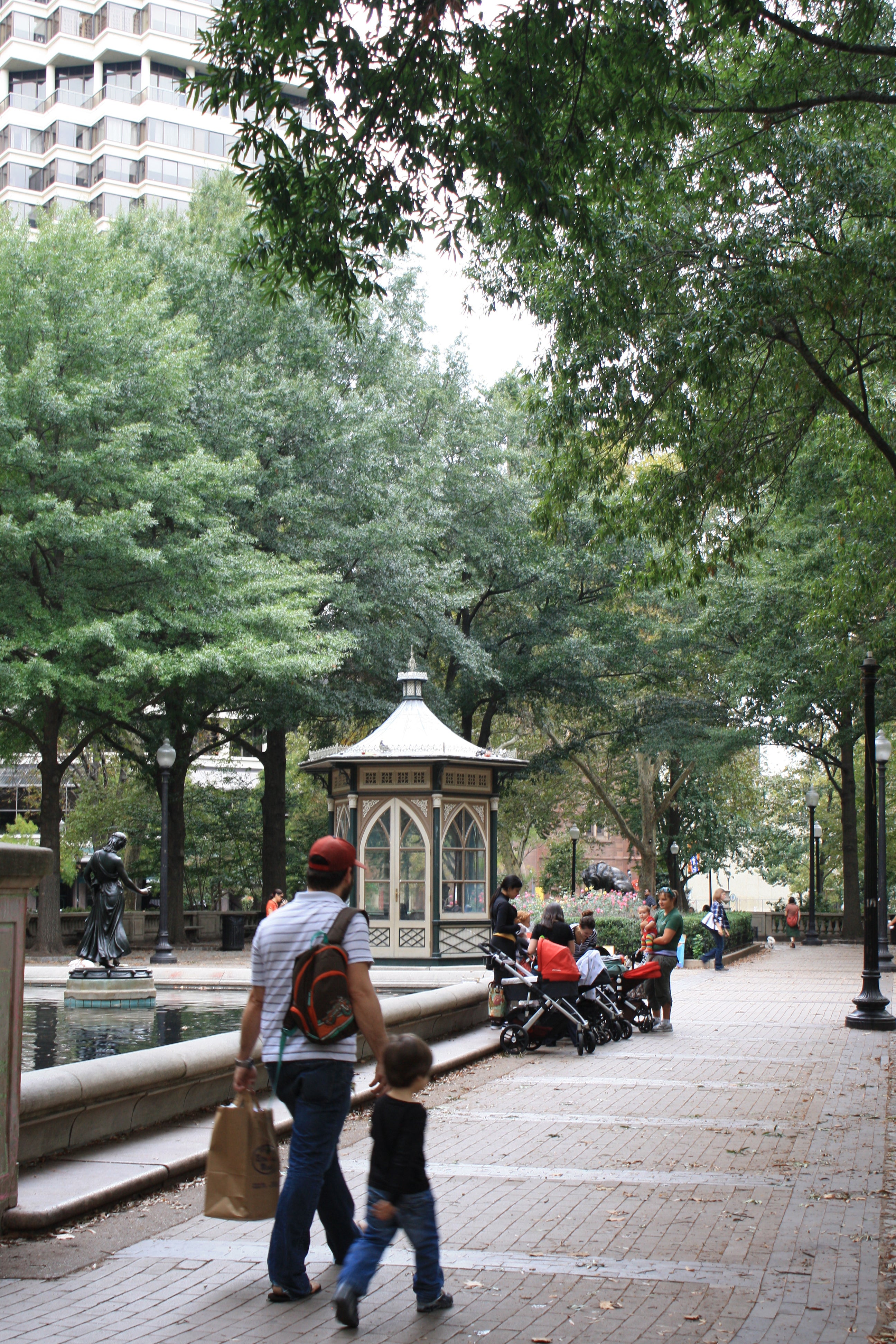Rittenhouse Square named one of America’s top public spaces
Rittenhouse Square has been named one of the top 10 Great Public Spaces in the country.
The American Planning Association chose to honor Rittenhouse Square because it is a beautiful, inviting public space that anchors a very vibrant neighborhood, and for the long-standing willingness of community members to fight to keep it that way, said APA Research Associate Tre Jerdon, a planner who helped winnow down this year’s applicants.
“For Philadelphians and tourists, Rittenhouse Square is a true landmark,” said APA Chief Executive Officer Paul Farmer in a written statement. “City officials and residents have done a spectacular job in carrying out William Penn’s original plan for their city and keeping Rittenhouse Square a remarkable public space.”
Jerdon said the success of Rittenhouse Square is obvious, from the beauty of the flower beds and trees, to the square’s use for ceremonies and festivals, dog-walking and lunch-eating.
Rittenhouse Square also got high marks for variability: The buildings that surround it are both commercial and residential. It is equally accessible by walking or taking public transportation. And a big cross section of people use it.
“The square is constantly alive with exercisers, people who work, school children, parents, people walking their dogs, elderly people, and visitors from other cities,” Jerdon said.
The Great Public Spaces awards are one of three categories of Great Place awards given annually by the APA since 2007.
With the Rittenhouse Square Award, Philadelphia has now won in all three categories. In 2008, Society Hill was named a Great Neighborhood and The Avenue of the Arts – South Broad Street – was named a Great Street.
“Like the Phillies, we think we can win one a year,” joked City of Philadelphia City Planning Commission Executive Director Gary Jastrzab.
Philadelphia nominated Rittenhouse Square for an award back in 2008, said David Schaaf, the PCPC’s director of urban design, who prepared the nominations. This year, APA suggested the city resubmit Rittenhouse Square for the public spaces award, Schaaf said.
(Schaaf and Jastrzab can already rattle off a list of spots that will be nominated for the planning world’s version of the Oscars in future years, including the river drives, the Benjamin Franklin Parkway, and the Art Museum/Waterworks.)
“As one of the oldest public places in the United States, Rittenhouse Square has demonstrated that a vision for a great urban place can, over time, produce a quality environment that has a unique identity,” said Philadelphia Mayor Michael Nutter in a written statement. “Now more than 300 years old, Rittenhouse Square is that place where all can find recreation, engagement, delight or the solitude they seek amidst the intense energy of a thriving city.”
The planning for Rittenhouse Square began 3,000 miles from Philadelphia in 1681. That’s when the idea for what was then called Southwest Square – and the other city squares – was conceived in London. The squares were surveyed the next year, when William Penn arrived.
“Early on, it was a place to herd animals,” Schaaf said. In addition to the local animals, the neighborhood was largely industrial then, and included brickyards, Jastrzab said.
Then in 1816, Philadelphians decided they wanted to enjoy the square themselves, and fenced the square to keep the animals out.
In 1825, the square was renamed for David Rittenhouse, the first director of the American Mint. And by the 19th Century, the square sat in the center of one of the most successful and prosperous neighborhoods in the city, Schaaf said. The square and nearby streets were lined with grand homes – most of which are now gone. The building that houses Urban Outfitters and Anthropology was such a mansion, Schaaf said, and the Curtis Institute was a grand townhouse.
In 1913, those living on and near the square used their resources to hire architect Paul Cret – one of the designers of the Parkway and the Rodin Museum – to create the pathways that cross the square. Fountains and statuary were also added.
“I would say that was probably the beginning of the true success of the square,” Schaaf said. “It was redesigned in 1913. In 1914, the Flower Market was established. The juried art show started later. It was the beginning of the civic function of the square.”
After 1919, the grand homes gave way to high rise buildings that allowed more people to live on the square, which continues to be a prestigious address. Learn more about Rittenhouse Square and its history in a document provided by Schaaf.
But what makes the area truly vibrant is that the square is used by so many people, even people who don’t live nearby, Jastrzab said.
In recent years, city planners have allowed the filing in of spaces where high rise buildings may have existed but were demolished, or where they never existed before, Jastrzab said, including 10 Rittenhouse Square. “We have also supported a mix of uses in the neighborhood surrounding the square, which makes it a vibrant, humming, urban place,” he said.
Philadelphia is lucky that Rittenhouse Square and so much of the city was created in the 17th Century before cars were invented and walking and horses were the main means of transportation, Schaaf said. It is that 17th Century scale that makes Philadelphia so walkable and bike-able today, he said.
“The best thing that can happen to Rittenhouse Square is that it gets maintained,” Schaaf said, adding that any major changes would require Historical Commission approval, since the park is on both the national and local registers of historic places.
The literal maintenance of the square is done through the city’s Department of Parks and Recreation and the Friends of Rittenhouse Square – the park’s advocacy group. Parks and Rec and the Friends will also receive plaques to mark the APA award.
“I can’t tell you how excited I am about this,” said Friends of Rittenhouse President Wendy Rosen. Rosen, who has been president of the organization for 16 years, is retiring in November.
Rosen said her organization has been able to raise a lot of money over the years to fund projects that the city couldn’t afford to do otherwise, including replacing the black iron railings around the park, lighting improvements, and work on the fountain, sprinklers and Gardener’s Cottage. Each project cost between $100,000 and $200,000, she said.
People love “the little green oasis in the middle of all these tall buildings,” said Rosen, who lives in the oldest of the tall residential buildings, 1830 Rittenhouse, which will turn 100 next year. When the Friends announced last year that, due to city funding cuts, there would be no holiday lights, people “came out of the woodwork” with donations, and restaurants held benefits, she said.
While she’ll no longer be president, Rosen said she will remain active in the organization. She hopes the Friends will soon provide new lights for the center of the square, and new sidewalks are also needed, she said.
The nine other APA 2010 Great Public Spaces are: Bryant Park in New York City, NY; Charles W. Ireland Sculpture Garden in Birmingham, AL; Fountain Square in Bowling Green, KY; Emerald Necklace in Boston, MA; Ferry Building in San Francisco, CA; Campus Martius Park in Detroit, MI; Percival Landing Boardwalk and Park in Olympia, WA; Plaza Real in Boca Raton, FL; and Main Plaza in San Antonio, TX.
For more information about these public spaces, as well as lists of the 2010 APA 10 Great Neighborhoods and 10 Great Streets, and designations between 2007 and 2009, visit www.planning.org/greatplaces.
Contact the reporter at kgates@planphilly.com
WHYY is your source for fact-based, in-depth journalism and information. As a nonprofit organization, we rely on financial support from readers like you. Please give today.






